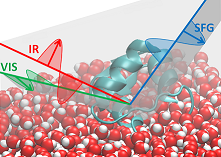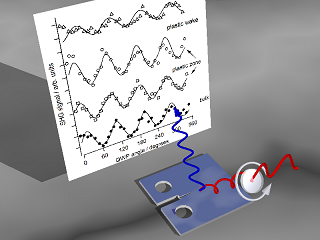Research Themes

1. Protein adsorption at interfaces

The interaction of proteins with interfaces can lead to denaturation and amyloid fibril formation. For a mechanistic understanding of this process it is crucial to know both the orientation and conformation of proteins at the interface, for which we are using sum frequency generation as an inherently interface-sensitive spectroscopy in combination with FTIR-ATR, QCM-D, XPS, SERS, fluorescence and reflection anisotropy spectroscopy.
Check out:"Insulin stabilized by a hydrophobic interface" in Langmuir
"The structure of insulin at the air/water interfaces: monomers or dimers?" in Phys. Chem. Chem. Phys.
2. Metal fatigue

Metal fatigue is an important subject for many industries such as automotive and aerospace. Existing methods to detect fatigue do not lend themselves to in-situ investigations. We have developed in-situ optical second harmonic generation to detect changes in the density of states caused by accumulation of disclocations.
Check out:Publication in Applied Physics Letters
Blog post by our collaborator Eann Patterson
3. Ultrafast surface spectroscopy
Vibrational energy is a prime reservoir for activating surface processes such as adsorption, desorption and reaction. On metal surfaces, vibrational energy flow occurs on a femto-to picosecond time scale and competing energy dissipation channels in this time range determine the outcome of chemical reactions at surfaces. We study the vibrational dynamics of adsorbates following femtosecond laser excitation of electrons, phonons or adsorbate vibrations by broadband sum frequency generation.
Check outDipole moment reversal in a polar organic monolayer in J. Phys. Chem. C
CO desorption by inelastic tunnelling in Chem. Comm.
NOx removal on silver/alumina: Science 324 (2009) 1048
4. Electrochemical interfaces
Molecular electronics uses metal-molecule-metal contacts as functional elements in electronic devices. The molecular structure (chemical, electronic, conformational etc.) is known to affect charge transport across the junction. For in-situ characterisation of such interfaces, we use sum frequency generation to monitor vibrational resonances as well as the local density of states at the metal electrode and the strong electric field generated by the 4-MP layer. We accompany these data with surface-enhanced Raman scattering, cyclic voltammetry and XPS.
Check out